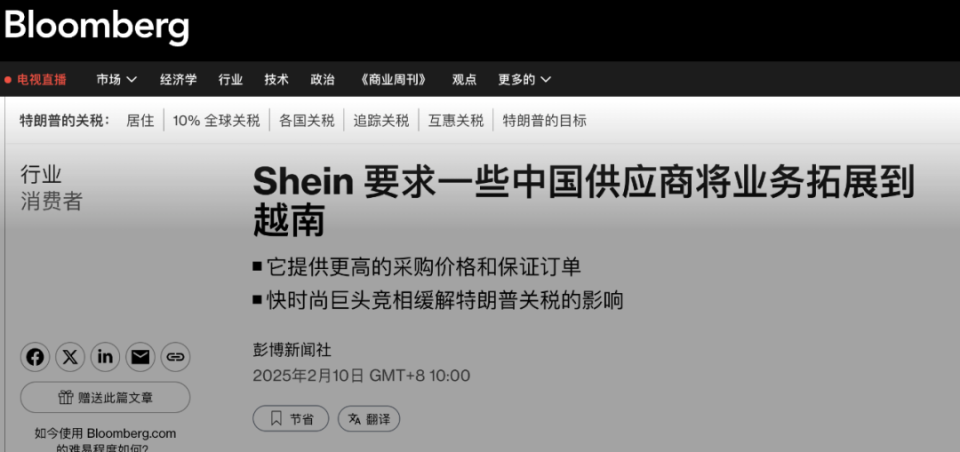
Facing the foreign trade storm with the United States, and not being led by the nose by the Americans
Overnight, the world was in an uproar. It was outrageous that the United States launched a global tariff war. Except for a few Commonwealth countries, no country in East Asia and Southeast Asia was spared.
Vietnam is often seen as a tax haven for Chinese takeout. Many Chinese companies have transferred part of their supply chains to Vietnam in an attempt to evade high US tariffs. Now the US tariff on Vietnam has soared to 46%, catching Vietnam off guard in an instant.
This time, the United States did not increase tariffs on Canada and Mexico, but instead significantly increased tariffs on Asian supply chain countries, which is bound to cause global economic chaos and will also force more countries to “de-Americanize.”
During the Trump 1.0 era, the world had begun to deglobalize and the global supply chain began to change dramatically; during the Trump 2.0 era, the global supply chain became more divided, the United States pushed for the return of manufacturing at all costs, and the ecological logic of US foreign trade was being reset.
Vietnam is no longer attractive
Over the past few decades, the global trade supply chain represented by clothing and apparel has been in the process of regional transfer. European and American orders have moved from Japan and South Korea to China, and then to Vietnam and Southeast Asia. This is a dynamic balance of the global economy due to factors such as regional economic development and labor costs.
Even without Trump, many Chinese factories have already set up shop in Southeast Asia, and Trump 1.0 accelerated this process. Many international brands’ OEM factories have moved to Vietnam, and many Chinese foreign trade supply chains have also set up factories in Vietnam. Even real estate investment has begun to look at Vietnam.
It can be said that before the US tariffs were launched, Vietnam had experienced at least a golden decade. Many Chinese economic experts also believe that Vietnam is the inevitable choice to take over China’s low-end industrial chain in the future. American brands have forced their own OEM factories to be built in Vietnam, which has greatly improved the supply chain capacity of Vietnam’s clothing and hats. Now Vietnam has become a competitor of China’s foreign trade.
According to Bloomberg, a well-known global media, Shein (Chinese name: Xiyin) is asking some Chinese suppliers to expand their business to Vietnam and provide policy support such as 30% purchase price incentives. The author searched for relevant reports and found that a large number of domestic reports have been 404 deleted.

In the past, Vietnam signed a free trade agreement with the United States, and its clothing exports enjoyed preferential tariffs of 5%-10%, and its labor costs were only about 60% of those in China; it was worthy of investment in the foreign trade supply chain.
4.3 As soon as the US tariff policy came out, Vietnam’s tariff policy advantage disappeared instantly. The current US government wants manufacturing to return to the US, rather than leaving jobs to one or another country in Asia. At this time, a large number of foreign trade companies that used Vietnam as a springboard were confused. It can be said that Vietnam is no longer attractive.
Cross-border e-commerce: where to go and where to hide?
The new U.S. tariff policy was implemented and officially took effect on April 9. Cross-border e-commerce will be the hardest hit. It must change its thinking on foreign trade with the United States. Whether it is small direct mail or wholesale model, it will be difficult to avoid this round of tariff war.
Trump’s 1.0 tariffs and trade war were mostly aimed at China, but China no longer cares so much. Trump’s 2.0 new tariff war is aimed at all national economies with large trade surpluses with the United States.
In the past, smart and capable foreign trade people could use countries like Vietnam and Thailand as subcontracting locations, but this is probably no longer possible, and Southeast Asia is no longer a tax haven.
The US tariffs on Singapore are relatively low. SHEIN’s parent company is registered in Singapore, but design and production are distributed in different places, mainly in Guangdong Province, and the supply chain layout is distributed around the world. It avoids the US tariff stick through flexible supply chains and distributed supply chains.
Under the current circumstances, the United States is moving towards closure, and cross-border e-commerce engaged in foreign trade with the United States seems to have nowhere to hide. SHEIN ‘s distributed supply chain costs will also increase, and it is not realistic to set up factories in places like Singapore and the United Kingdom.
If you want to do business with Americans and avoid tariffs, you can only build factories in low-tariff countries and assemble in the United States. However, if you do this, there will be a lot of problems such as public security, labor costs, worker quality, local compliance, etc., and the business uncertainty is extremely high. What’s more, under Trump’s rule, the United States can increase tariffs on other countries with just a word, which itself is a huge uncertainty.
Originally a foreign trade business, but eventually forced to become a foreign company, and having to wander in a foreign country all day, not everyone can stand this kind of wandering business. Most of China’s foreign trade supply chain companies are not novices, most of them already have families and successful careers, and some risks are unnecessary.
At least in the next few years, foreign trade with the United States will not be a spring, but it is not ruled out that there will be breakthroughs in the form of brand premium. If some foreign trade brands can become world-famous brands through design and marketing, significantly increase their gross profit level, and compete with the high-end ecology of the US market, then such brands may not care too much about the impact of tariffs.
Re-understanding the Chinese market, the Canaan of shein
Investing in China is investing in the future. I believe this statement very much, because China is the safest, most gentle, and most inclusive market, and it also has a large number of the smartest and most capable talents. If you want to find a pure land in troubled times, I definitely think China is it.
Many industries in China have the problem of internal competition. However, China has no structural risks and does not like to play the hegemonic mode. If China wants to find business opportunities in a peaceful ecology in the future, it is more appropriate to use China as a strategic fulcrum.
Under the complex political and economic environment, the world is unlikely to return to the past in the short term. Why did Zhang Yiming dare to die rather than sell TikTok? Because ByteDance’s headquarters is in China. Even if the Americans don’t allow you to do business normally in the United States, you can still rely on China to conduct business cooperation with other countries around the world.

SHEIN is in a difficult situation. The parent company is already located in Singapore. The distributed supply chain model has achieved great success, but there are strategic risks in only doing business overseas and not in the Chinese market. It is not realistic to completely break away from the supply chain of Made in China, and thus lose the advantage. This is definitely not an option. However, with the current thinking, the narrative logic of the identity puzzle has always been one of the factors affecting the listing.
Professor Zhai Dongsheng of Renmin University of China , who predicted the Sino-US relations ten years ago, once said that the Chinese are the smartest group on earth. They are not born to be suitable for jobs like tightening screws in factories, but are more suitable to sit in office buildings and do high-end work such as design and research and development.
I believe that Made in China is in the process of upgrading, whether it is the transfer of the manufacturing supply chain to the western region or Southeast Asia. However, in the industrial chain, Made in China should be the chain leader that controls profits and productivity, rather than working hard and making cheap goods for Americans.
The Americans are simply influencing the global economy and finance through the exchange rate of the US dollar. However, in the new cycle, Chinese manufacturing and Chinese intelligent manufacturing should be prepared to face the storm of foreign trade with the United States and not be led by the Americans. When it is time to raise prices, they should do so instead of forcing their own supply chain brothers to run around.
Some economists point out that the policies of the Trump 2.0 era are very similar to those of the United States before World War II, and may even trigger problems such as the Great Depression in the United States, which means that trade with the United States may get worse and worse. Many people are obsessed with worshipping the old United States and are relatively numb to the changes taking place in the world, which is very dangerous.
The author suggests that pure foreign trade companies like sheyin should have a sense of strategic crisis, return to the Chinese market as soon as possible, and build a good base in China , so that they can be more stable and fearless in the chaos in the world. At the same time, they should also have a bottom-line thinking and do a good job in the new global trade in non-US markets .
Under the current circumstances, China is the land of Canaan. When doing foreign trade, try not to just focus on foreign countries. You must work hard to do a good job in the Chinese market. The combination of internal and external circulation is the safest and most reliable e-commerce layout.


